Over a third of species in Switzerland are threatened with extinction. Switzerland is an important player in environmental diplomacy, but balancing ecological conservation with economic growth is a complex challenge. This blog explores the importance of biodiversity and the economic challenges it poses.
A global leader
The Confederation’s active participation in international agreements such as COP15 and the adoption of the Kunming-Montreal Global Biodiversity Framework demonstrate the importance of the topic at the international level. At COP15, Switzerland strongly supported the ambitious target of protecting 30% of the world’s land and marine areas by 2030. Franz Perrez, the Swiss ambassador for the environment, highlighted Switzerland’s commitment to implementing the framework domestically and internationally. This leadership extends beyond Switzerland’s borders, as evidenced by initiatives like the Swiss State Secretariat for Economic Affairs’s (SECO) NatureFinance project, which supports biodiversity financing in developing countries.
National commitment
On September 22, Swiss voters will decide on the „Yes to Biodiversity“ initiative, which seeks to protect nature by increasing funding and expanding protected areas. While failure to respond could damage social well-being, nature and tourism, the initiative could limit land use for agriculture and renewable energy. The initiative proposes changes to the Swiss constitution, obligating the cantons and federal government to allocate more land and funding for biodiversity and landscape protection. Environmental groups like Pro Natura, Patrimoine Suisse, and BirdLife argue that the current protective measures are inadequate and will not prevent the costs of biodiversity loss (estimated at CHF 14 to 16 billion per year by 2050). In contradiction, the Swiss government estimates that implementing the initiative could cost CHF 215 million annually, and the federal government already invests around 600 million CHF annually, which represents 0.79% of the GDP. Its commitments have increased over the years, as the table below shows. Furthermore, the confederation plans to spend an additional 2.207 billion by 2028 to environmental protection independently of the “Yes to biodiversity” initiative.
Percentage is calculated as a ratio of direct federal biodiversity related expenditure and GDP at current prices in million CHF. Sources: FOEN & Swiss FSO
Effects on agriculture
Despite the fact that 73.6% of the Switzerland’ GDP originates from its tertiary sector, agriculture remains very important to its citizens. The country produces 59% of its food needs and aims to increase food self-sufficiency to 70%. But while intensive farming practices are essential to meet growing food demand, they often lead to habitat loss and the decline of species. To address these issues, the Swiss Biodiversity Strategy (2017) promotes sustainable land use, but implementation is complicated by economic realities. However, many Swiss farmers argue that biodiversity regulations, such as restrictions on pesticide use or requirements to maintain hedgerows, can reduce crop yields and increase operating costs. Moreover, Switzerland is a significant food exporter and has over 280 influential Swiss FoodTech startups and ecosystem partners, R&D laboratories and incubators.
Spatial planning
Urban expansion adds another layer of complexity. The Federal Office for the Environment (FOEN) reports that Switzerland’s built-up areas have expanded by over 30% in the last 40 years. Between 2009 and 2018, nearly eight football fields of land were developed daily, leading to habitat fragmentation that isolates species and threatens their survival. However, infrastructure development is essential to accommodate the growing population. A study conducted in the canton of Valais found that failing to implement revised spatial planning regulations could result in a gross value-added loss of at least CHF 1.3 billion over ten years due to reduced construction activity and hindered population growth. Such challenges are compounded by Switzerland’s already high property prices, which could rise further if infrastructure needs are not addressed. The task is to find a balance between development and preserving natural habitats.
Balancing Conservation and Economic Growth
Prioritising biodiversity will require significant investment, but inaction could result in even higher financial losses over time. Switzerland has committed internationally to adopting an equitable and comprehensive framework to address biodiversity loss, with clear targets to tackle overexploitation, pollution, and unsustainable agricultural practices. The Kunming-Montreal Global Biodiversity Framework obliges the countries to drive finances toward sustainable investments and away from environmentally harmful ones. These global responsibilities, combined with domestic action, require the country to continue leveraging scientific expertise, innovative policies, and balancing all stakeholders‘ needs to reach a solution. Switzerland must go beyond current initiatives by integrating biodiversity protection into every sector of the economy.





